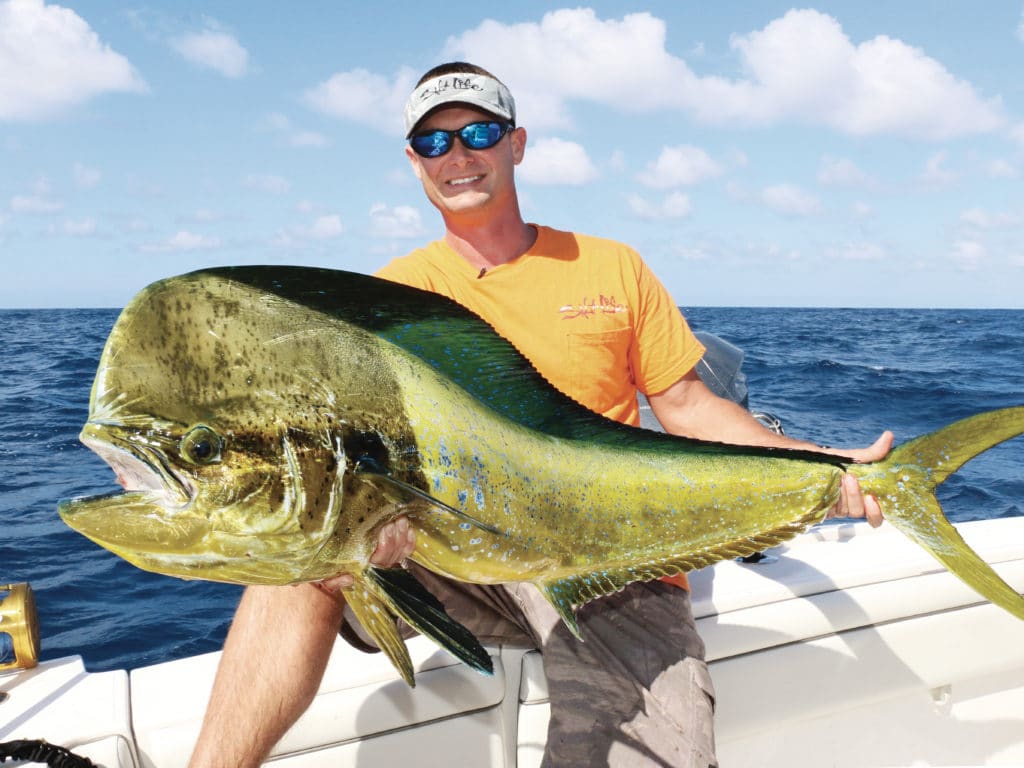
The galactic splendor of the Milky Way lit up the pre-dawn sky as I lay in a beanbag in the aft cockpit of Alex Laing’s Jupiter 34 FS, White Noise, and reveled in the magic of a night passage. Now more than 100 miles from our starting point on the island of Grand Cayman, we aimed for a small and desolate seamount in the western reaches of the Caribbean, a bank closer to the waters of Honduras than those of our home port.
A half-hour later, Laing pulled back the throttles on the twin Yamaha F350 outboards. I pulled myself from the beanbag and glimpsed the purple glow of a new day on the eastern horizon. No other boats in sight.
After a four-hour run, we had reached our target: the 110 Bank, named for its distance in nautical miles from Grand Cayman. Running around from the back side of the island added another 30 nautical miles to our passage. The sun would soon rise. Now was the time to see what dividends this bank had to offer.
Some of the crew, including Jupiter Marine president Todd Albrecht and Sport Fishing publisher Dave Morel, had been up for hours. Waking with me were Cayman Islands residents Nathan Day and Joe Pearce. “That was a pretty nice trip,” said Pearce, general manager of Pro Yacht, the Jupiter Marine boat dealer in the Caymans. Laing’s 34 had sliced smoothly through the three-foot head seas en route to our far-flung fishing spot, the cushy ride giving me a chance to nod off between moments of stargazing.
Rolling waves smoothed abruptly by upwelling currents provided evidence that we floated atop a high spot in the ocean floor. The big question on our minds: Were there fish here?
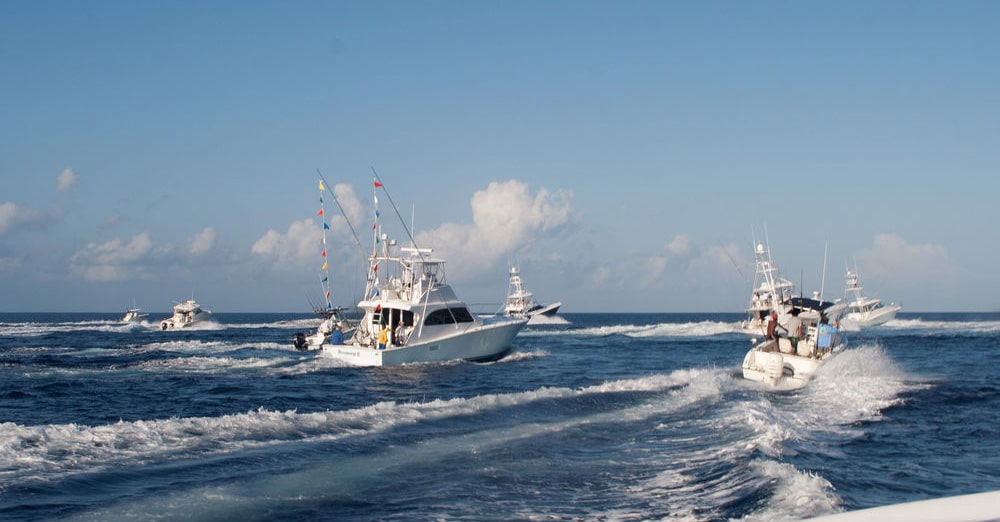
Tournament Driven
What drove us to run so far from the idyllic beaches of Grand Cayman? Pursuit of tournament glory. This was the second of the four-day 18th annual Cayman Islands International Fishing Tournament, a competition staged each April under the auspices of the Cayman Islands Angling Club. I had the pleasure of joining the crew aboard White Noise for a couple of days during the 2015 event.
Twenty-four hours earlier, our morning aboard White Noise had started quite differently. Rather than departing in the dead of night and greeting the morning on a vast, empty ocean, our team had joined a throng of boats in Grand Cayman’s bustling main port of Georgetown Harbor. We lingered amid anchored cruise ships and more than 30 other sport-fishing boats of every shape and size, talking and laughing with other captains, awaiting the official Bimini start of the tournament while cruise ship passengers waved to us from their stateroom balconies above.
The tournament director’s voice crackled over the VHF, and the boats lined up for the start. Time to go. Boats pinned their throttles and raced out of the harbor, en route to their chosen fishing spots.
Our boat joined the spectacle, but soon we peeled off, as Laing had decided to hang close to the island on the first day in pursuit of mahi and wahoo. He headed southwest, looking for productive weed lines and bird activity less than a mile off the island.
The idea of trolling for bluewater species so close to shore puzzled me, particularly because these islands lie so low. The average elevation of the 22-mile-long Grand Cayman, for example, is just 79 feet. For comparison, Florida’s mean elevation is 100 feet.
I assumed Cayman’s inshore waters were correspondingly shallow.
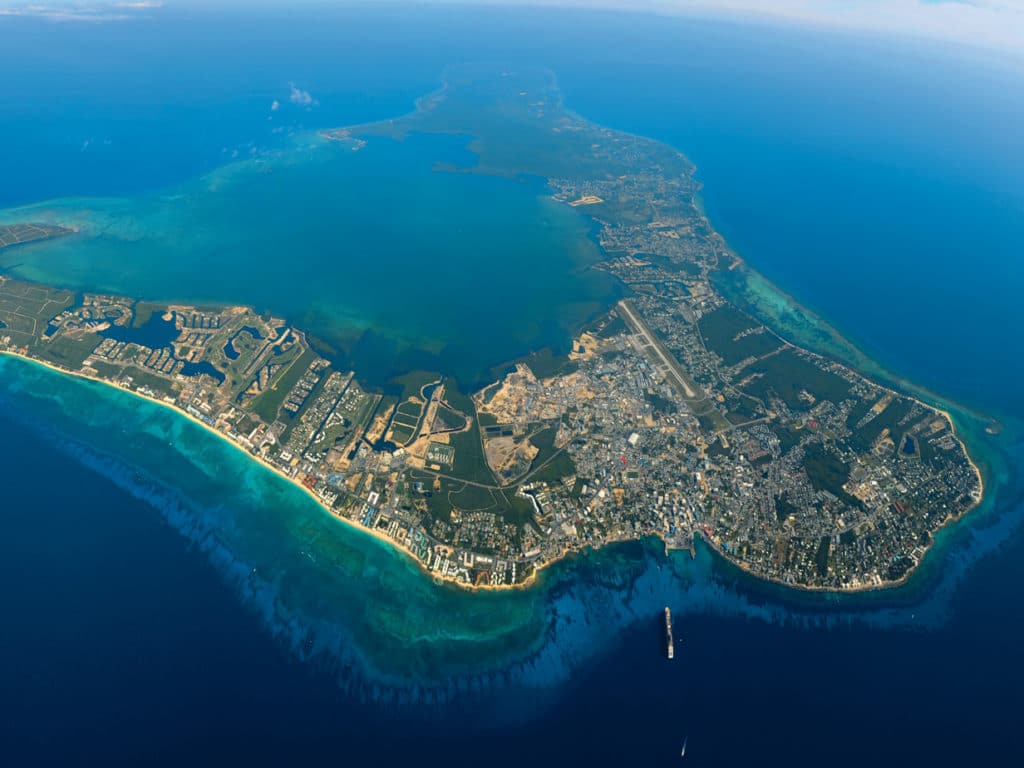
Precipitous Shores
A review of a bathymetric chart for the waters surrounding Grand Cayman and its sister isles of Little Cayman and Cayman Brac reveals the true nature of these marine habitats and fisheries. Despite the low terrain, the islands are actually mountaintops, plateaus of the Cayman Ridge that rise precipitously from depths as great as 20,000 feet along the Cayman Trench to the south.
Formed over the eons by tectonic collisions between the North American and Caribbean plates, the ridge stretches more than 930 miles from Cuba’s Sierra Maestra Mountains to the Gulf of Honduras. So these islands are essentially the exposed portions of seamounts, like the 110 Bank, but supersize.
Marine currents swirl upward from adjacent depths and sweep across the submarine slopes of the islands, creating upwellings that nurture copious plankton to form the foundation for a rich marine ecosystem and, at times, spectacular fishing. Here you might find blue marlin, mahi, swordfish, tuna and wahoo.
Since you need not run far to enjoy these conditions, boats as small as 20 feet can get in on the action. In fact, a number of wahoo have been caught in the shadows of the cruise ships in Georgetown Harbor, including a 133-pound ’hoo weighed a couple of weeks before the 2015 tournament.
Anglers also deep-drop for daytime swordfish in depths of 1,000 feet or more, while drifting less than a mile off the world-famous Seven Mile Beach north of the harbor. Later in our trip, we watched while one of our Jupiter 34 sister ships, Volatility, battled a swordy astonishingly close to the beach. Unfortunately, the hook pulled two hours into the fight.
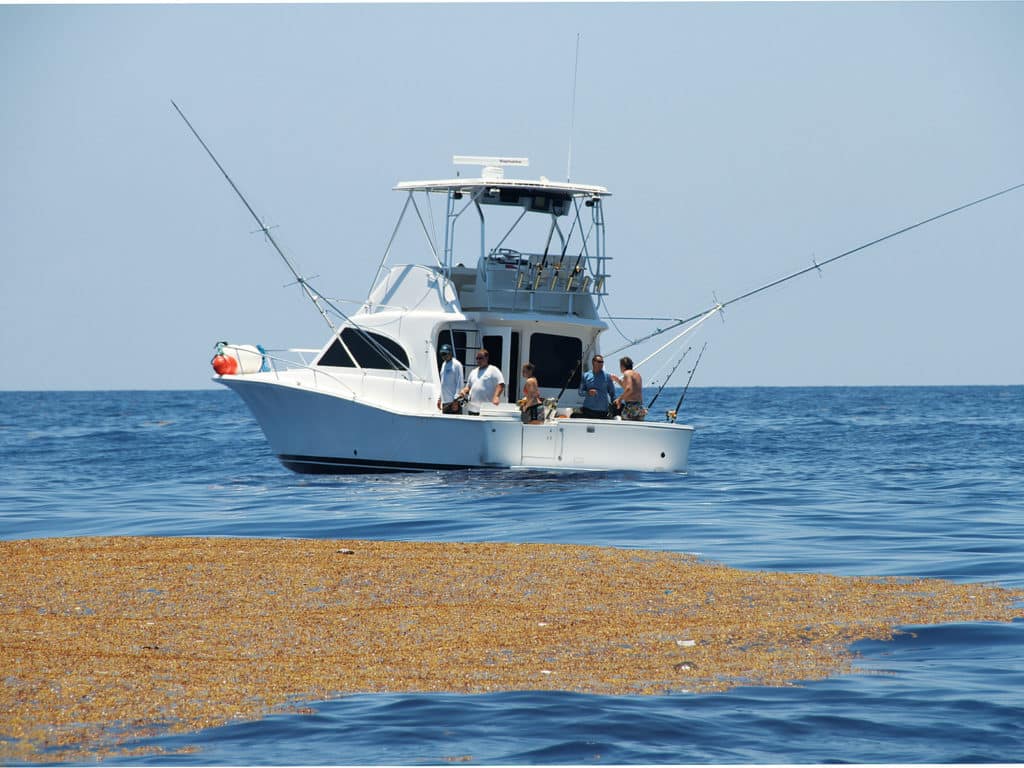
Nearby Mahi
Trolling close to the island on day one paid off for us when we spotted a quartet of frigate birds descending rapidly near a weed line. Laing swung the wheel over hard to place the trolling lines under the frigates, and within seconds, a mahi attacked the port rigger line. Albrecht picked up the rod to battle the brightly colored, high-flying bull mahi from the aft deck. We iced it in one of two 104-gallon fish lockers below the aft deck. It turned out to be the first of seven dolphinfish we would catch on our first day of tournament action.
In addition to working weed lines close to the island, we trolled out to a spot called the 12-Mile Bank, west of Georgetown, where we hoped for a marlin, tuna or wahoo to round out the day, but ended up finding even more mahi.
At the weigh-in at the Barcadere Marina in the southwest corner of Grand Cayman’s North Sound, we discovered our biggest fish weighed 28 pounds, putting us on the board for the time being. With 59 boats — including teams from the other two islands — and three more days of tournament fishing, Laing felt we had to up our game and add more species to our tally. He felt the need to go long and fish waters where few other boats dare venture.
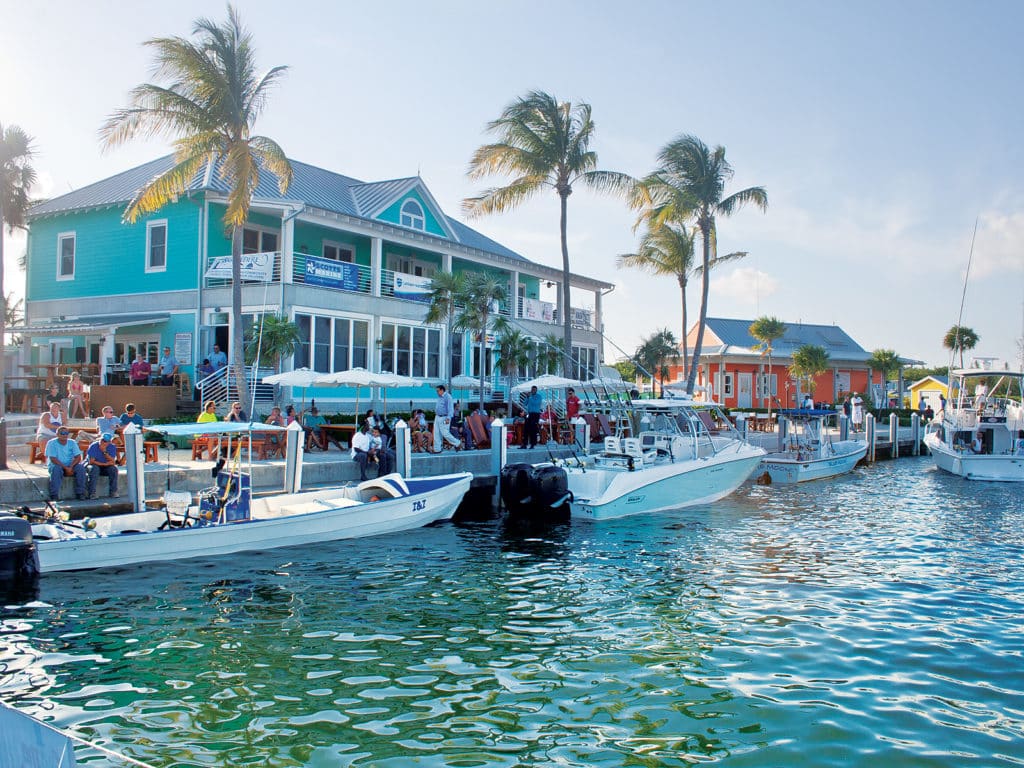
Bank On It
Try a Google search of “banks of the Cayman Islands,” and you’ll find a raft of advertisements for places to stash your money. The Caymans have long been known as a financial haven for those wishing to minimize taxes and hoard secret funds.
Yet for anglers, the real treasure lies in the banks that rise from the ocean floor around these islands, and there are a few. Our crew had a choice between the 60 Bank, Pickle Bank and the 110 Bank. After gathering as much intel as he could, Laing decided to go to the most distant of these, the 110.
After catching a couple of hours of sleep at the hotel, we met at the dock at 1:30 a.m. the next day and were underway by 2:30. The crew set trolling lines shortly before sunrise, pulling rigged ballyhoo from the outriggers and one flat line, plus a cowbell-style skirted lure or a lipless plug such as a Halco Trembler from a downrigger set at a 30-foot depth. Everything gets a wire leader in case a wahoo bites. Laing kept the trolling speed at about 7 knots and tacked at various angles across the high spot, which rose steeply on all sides. Sonar indicated it reached to within 120 feet of the surface at its peak.
I joined Laing at the helm and asked what it takes to fish such distant banks from a 34-foot center-console. “It’s not a run for the faint of heart,” said Laing in his native Canadian accent. “Nathan [Day] and I fish this spot quite a lot, but we only go when the weather is decent, the engines are running well, and the boat is fully fueled.” Laing ordered his Jupiter 34 with a 65-gallon auxiliary fuel tank, bringing his total fuel capacity to 390 gallons.
Having multiple outboards is more important than ever when fishing off the Cayman Islands, because there’s no such thing as the Coast Guard or a subscription towing service here. “If you break down, you call one of your buddies to come out and tow you in,” Laing explained. The captain also carries an emergency life raft in case of a dire situation.
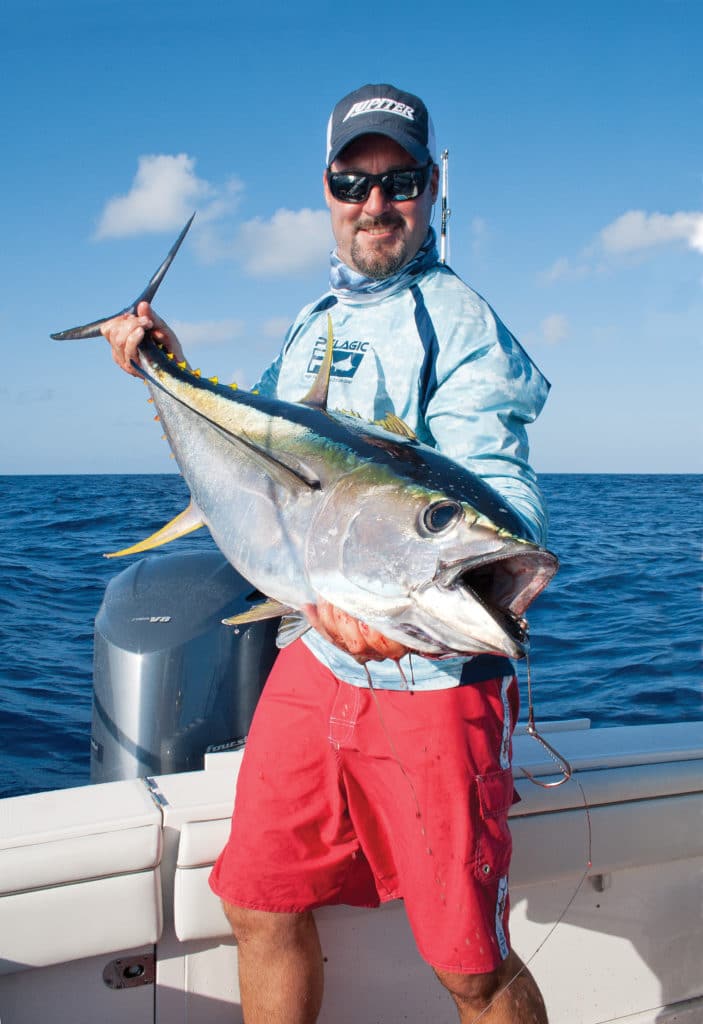
Tuna Yield
The zing of a clicker cut our conversation short as a fish inhaled the rigged ballyhoo on the flat line. Morel picked up the rod, a choice he began to regret once he discovered the reel’s drag had malfunctioned. There was not enough tension to gain line; instead line continued to pour off the reel. This led to the unorthodox but effective technique of pulling in line by hand while quickly gathering it on the reel. After an awkward, protracted battle, Albrecht sank a gaff in a 51-pound yellowfin tuna.
Back on the troll, we quickly hooked another yellowfin, but this time the reel worked just fine, allowing us to land a 48-pounder. After that, the tuna seemed to evaporate or at least ignore our trolled offerings. So Laing and Day decided to shut down and drift-fish with chunks and live bait.
“Some of our most productive days have been the result of drift-fishing on banks such as the 110,” Laing explained. “We catch a lot of tuna this way.”
A key to successful drift-fishing lies in having wind and current travel in the same direction. “Fishing is best when the two are moving together,” Day says. During our trip to the 110, conditions proved favorable.
Day also pointed out that the water directly on top of such banks is not the most productive, at least for the species we were targeting. “That’s barracuda territory,” he said in his British accent. “You definitely want to steer clear of those fellows.”
The best area of the bank is the up-current side, Day revealed. So the idea is to start the drift as much as a mile up-current or upwind of the high spot, where depths plummet to 1,000 feet or more, then reset once the water becomes shallow again, as indicated on the sonar.
Grand Cayman Mystery Fish
We baited Mustad 5/0 circle hooks with chunks of Spanish mackerel and blackfin tuna and paid out 100 to 200 feet of line — no sinker, just free-lined. In the meantime, Day and Morel worked Butterfly jigs, catching a variety of jacks and small blackfin tuna in the mid-depths. Albrecht used one of the small tuna as live bait, and he was rewarded with a bite from something big.
Line melted off the 80-wide reel as the fish sped toward deeper water. Laing gave chase, allowing Albrecht to put line on the spool, but soon it turned to a stalemate, the monster refusing to budge. As the fight dragged on, speculation among the crew ran the gamut from blue marlin to big grouper, but it all ended when the leader parted.
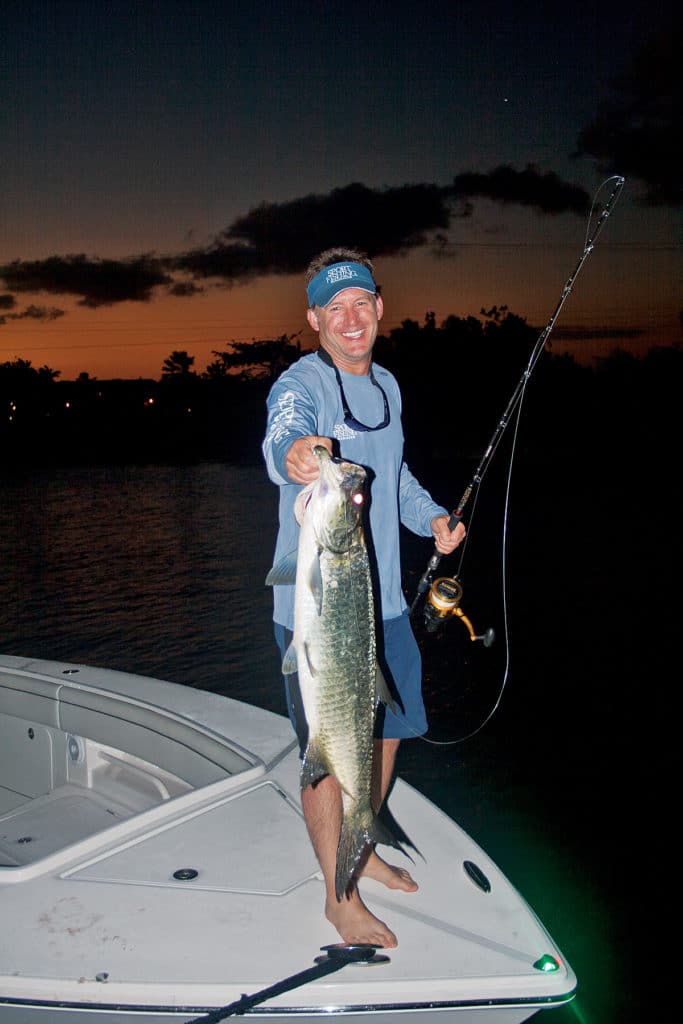
After several more drifts over the bank and catching a number of small tuna, mahi and jacks, it was time to prepare for the long run home to make it back in time for weigh-in. The crew took turns manning the helm, giving those who got no sleep the night before a chance to snooze.
With the seas now on our starboard beam, the Jupiter 34 loped along comfortably. Setting the speed at 27 mph and 4,100 rpm ensured near-maximum efficiency, a key factor on our 280-nautical-mile round trip. The twin Yamaha F350s burned 24 gallons per hour, achieving 1 mpg.
Our course to Grand Cayman took us along the length of the Cayman Ridge, and we saw a number of areas of bird activity that would likely have yielded more fish, but time was short and we dared not stop.
Hours later, we were back at the Barcadere Marina, where Morel’s 51-pound yellowfin put us on the board again. That was our cue to celebrate with a round of rum drinks as we mingled with other anglers during the weigh-in. Morel’s fish was eventually knocked from overall contention, but it did place in the money for the biggest tuna on day two for a Grand Cayman-based team.
My time to leave Grand Cayman had come, so I bid farewell to my new fishing friends. Back at home, when people ask me what I did in the Cayman Islands, I tell them that I visited banks and learned where an angler can strike it rich.
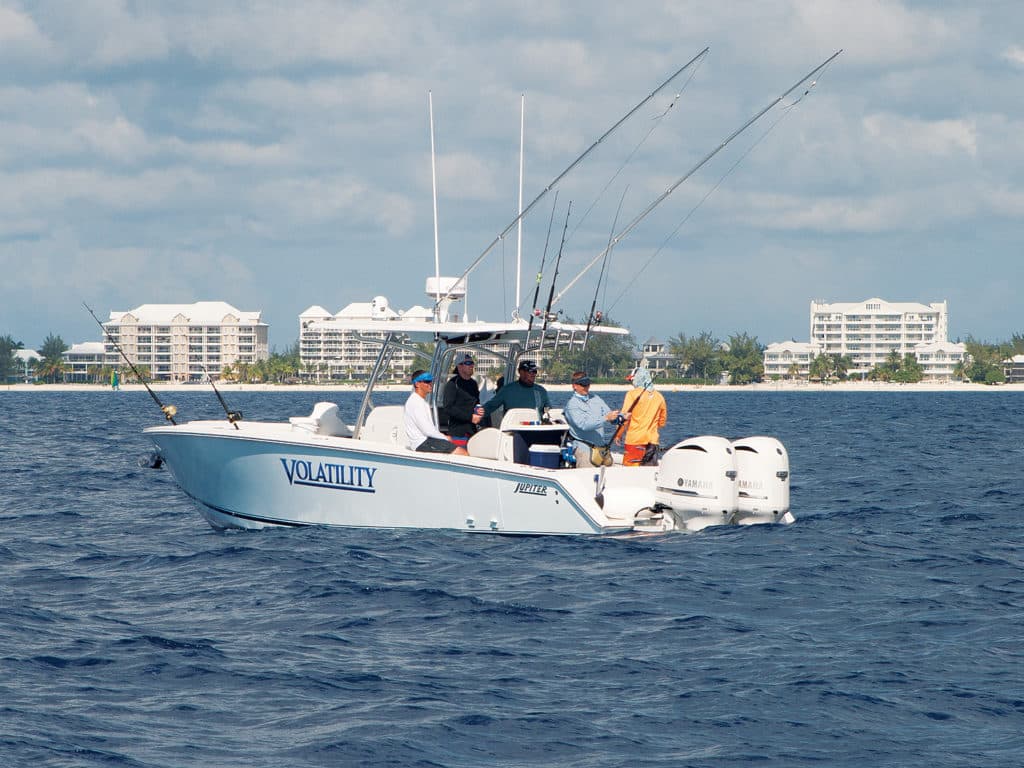
Our Boat: Jupiter 34 FS
The Jupiter Marine 34 FS center-console proved ideally suited to fishing the waters surrounding the Cayman Islands. The 33-foot-9-inch V-hull features 24 degrees of deadrise at the transom for smooth cruising. A 10-foot-5-inch beam provides outstanding stability, an important consideration when fishing a six-person team, as we had aboard Alex Laing’s 34 FS, White Noise.
The fiberglass uni-grid stringer system, high-density ceramic-matrix-core transom, and hand-laid multidirectional biaxial and triaxial knitted fiberglass construction result in exceptional durability and a hull that rides with quiet confidence.
Twin 104-gallon insulated fish boxes in the aft deck, a 45-gallon livewell abaft the helm seating, and two 7-cubic-foot lockable rod lockers are just a few of the many fishing features aboard the 34 FS.
With the standard 325-gallon fuel capacity augmented by the optional 65-gallon auxiliary tank, the 34 FS offers the range to fish distant areas such as the 110 Bank. While the boat is rated for up to 900 hp, the twin Yamaha F350 outboards seemed like the ideal configuration for the 34 FS, offering a great blend of power and efficiency. To learn more, visit jupitermarine.com.

Plan a Trip to the Cayman Islands
Bluewater fishing is just part of the story in the Cayman Islands. The bays and harbors abound with tarpon. In fact, as we were cleaning the boat in the evening, Sport Fishing publisher Dave Morel (right) baited up with a chunk of fish and cast into the marina channel. Within minutes, a tarpon went airborne and the rod bent double. Morel got three more leaps from the 20-pounder before bringing it boat-side for photos and release.
Want to experience the magic of fishing in the Caymans? Here are suggestions for setting up the trip.
Flights
A number of airlines serve the Cayman Islands. American Airlines and Cayman Airways both offer daily nonstop flights between Miami and Grand Cayman, while Jet Blue flies nonstop between New York Kennedy and Grand Cayman.
Accommodations
I found clean, comfortable and affordable accommodations at the Comfort Inn and Suites Seven Mile Beach in Grand Cayman. It is just steps away from the famous white sand beaches along the western shore of the island.
Charter Boats
While I fished on a private boat, a wide range of charter fishing boats are available for hire in the Cayman Islands. One of the best-known operations is Reel Esea Charters. Capt. Dwight Ebanks is a native of the Caymans with 30 years of angling experience in the islands. He fishes blue water aboard his 31-foot Bertram, Reel Esea. Members of the Ebanks family often join the crew.
For more choices in charter fishing services for the Cayman Islands, visit fishcayman.com/charter.








